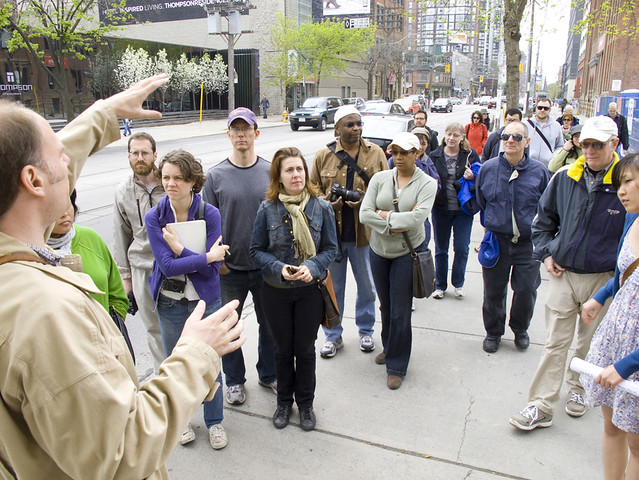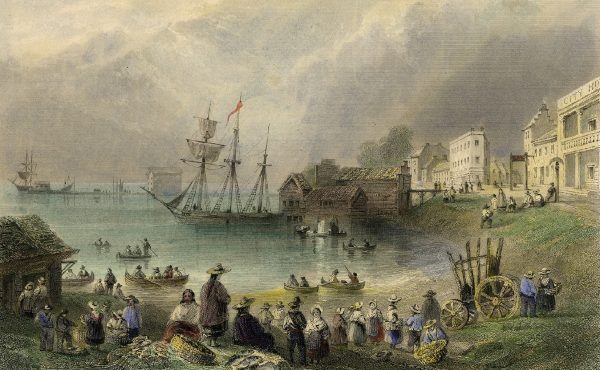
This regular online series will feature interviews with fascinating and influential urban thinkers, with a focus on discussing how Toronto can become a more engaged, accessible, and sustainable city.
Every year, Jane’s Walk organizes a series of interactive tours in various Toronto neighbourhoods. Spacing sat down with Jane Farrow, executive director of Jane’s Walk, to discuss the event’s broader objectives.
Spacing: What is the rationale behind Jane’s Walk?
Farrow: Jane’s Walk started as a way to mark the passing of Jane Jacobs, the most influential urbanist of our time. It quickly established itself as a way to celebrate neighbourhoods by getting locals to share their neighbourhood specific knowledge with interested parties. It also serves as a form of civic engagement by getting residents involved in their neighbourhood, or at minimum, thinking optimistically about civic engagement. Its other goals are to connect people, narrow social distance and increase social cohesion. Jane’s Walk also aims to enhance our understanding of what walking environments are and to help people devise improvements.
Spacing: What is the typical format for a “walk”?
Farrow: A five or six stop tour with observations and stories, ideally with questions posed to the audience to encourage participation. Getting participants to ask questions or contribute to the conversation is key. The aim is to validate each other’s perceptions of public space. There is some really important and detailed information that people posses unknowingly that is useful for coming up with new neighbourhood plans.
Spacing: How does Jane’s Walk reflect the philosophy of Jane Jacobs?
Farrow: Jane’s Walk really picks up on some of the very basic ideas that Jane espoused in The Death and Life of Great American Cities, ideas that were initially revolutionary but are now common sense, such as mixed use, active sidewalks, eyes on the street, make it connected, vibrancy, density, good public spaces, old buildings need new ideas, etc… Hopefully, Jane’s Walk provides an introduction to her ideas. After that, participants are free to experiment. There are people who lead walks that don’t know anything about Jane—but that’s not what matters. They just want to talk about their neighbourhood with interested people.
Spacing: Jane’s Walk is often described as a mechanism for cultivating urban literacy and civic engagement. How so?
Farrow: Our approach to Urban Literacy is showing people that they know more about their city than they realize. People understand good urban design experientially. The goal is to validate that kind of nascent urban literacy and encourage its growth while helping people realize that the majority of problems in our neighbourhoods are actually design-oriented. Our neighbourhoods could be built better. For instance, if buildings had interaction with the sidewalk, it makes streets more lively and allows for cafes, which bring people out onto the sidewalk. People, in turn, feel safer, and you get a nicer place to walk.
Spacing: To what extent then is Jane’s Walk about getting citizens involved in planning?
Farrow: We seek to get people connected to how decisions are made. When someone calls 3-1-1 or tells their local councilor “this park bench needs fixing” and then something happens, it isn’t just a park bench that got repaired, but an active citizen got validated. Whereas, if someone tries to improve something and nothing happens, then another type of citizen is created, one who is disengaged and doesn’t believe in the system. That may even show up as “I’m not going to bother to vote because nothing I do or say matters.” People fundamentally care about where they live but they don’t know how to have an impact. Jane’s Walk is hopefully trying to narrow those distances and to promote and encourage people to get engaged and care.
Spacing: You’ve been involved in assessing walking conditions in Toronto’s inner suburbs. What kind of information did you gather?
Farrow: There are more pedestrians in high-rise neighbourhoods than statistics show. Officials assume that high-rise residents have a car. However, many residents forego that luxury and rely instead on unreliable transit and inhospitable walking conditions. They face a lot of obstacles in terms of connectivity such as street design, i.e. the cul-de-sac and the inner street structure. There is also a lot of enclosed fencing. Sometimes it’s not possible to walk directly from your apartment tower over to the neighbouring mall without going through a secret hole in a fence. If you’re a parent, you certainly can’t drag your stroller through there. The surrounding terrain might also be muddy. The other obstacle is arterial traffic. Barreling down a six or eight lane road, many drivers don’t recognize that pedestrians are present. Overall, it’s bad design.
Spacing: What do we need to do to make the city more walkable?
Farrow: Adopt an action plan in accordance with the pedestrian strategy voted on and supported by council. The City has a great plan that just has to be implemented. Stop handing out tickets to pedestrians when a pedestrian fatality occurs. Think in terms of complete street design that considers the safety of all road users. Better street design can minimize the risks and make it safer for everyone.
Spacing: What are you doing for Jane’s Walk?
Farrow: I recently moved to a different part of the east end and I love it. Therefore, I’m doing a walk called ‘Dirt: The Good, The Bad and the Sexy’ which is all about my community coming together to achieve a soil remediation goal. It’s also about a landmark stripper club called “Jilly’s” which some consider a stain on the neighbourhood but others believe is one of its best features. I’m also co-leading a walk with Paul Hess called ‘Darkness and Light.’ It’s a story about the city’s street lighting grid which looks at the science and engineering as well as our psychological need for lighting.
Spacing: If someone wants to lead a walk next year?
Farrow: Go the webpage and submit a walk. Anyone can lead one. Self-organization is an important principle in Jane Jacobs’ work. Don’t wait for permission, especially if you know what needs to happen. Alternatively, go find out if you have the motivation. Just don’t sit around waiting for a permit
Photo by Alexandra Guerson




